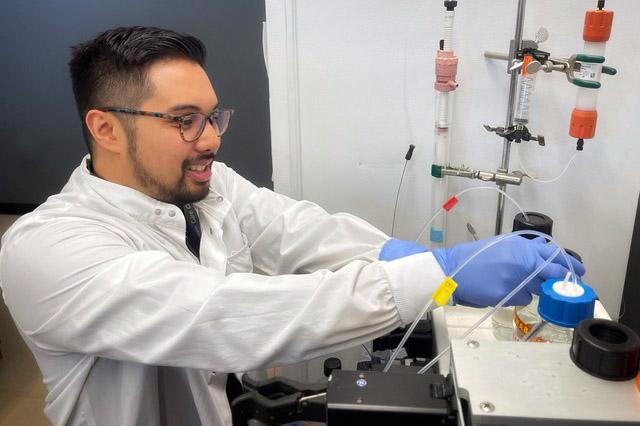
Signaling proteins shown to play key role in TB biology
Findings suggest a largely overlooked cellular signaling system may play a more important role in bacteria than previously thought.Media Contact: Leila Gray, leilag@uw.edu

A set of 10 signaling proteins found in the microbe that causes tuberculosis [TB], play a far larger role in regulating the bacterium’s growth, development and behavior than previously thought, according to recent research. The study was led by UW School of Medicine and Seattle Children's researchers..
TB remains a deadly disease that kills more than 1.6 million people worldwide a year. Drugs are available to treat TB, but they are difficult to take. Patients often need a handful of pills a day for many months. In addition, multi-drug resistant strains that are essentially untreatable are a growing threat. It has become increasingly important to develop new treatments.
“Our findings address a fundamental question about biology but because these are very ‘drugable’ proteins, the findings may help find drugs that can treat the permanent pandemic of TB.” said Christoph Grundner, principal investigator at the Seattle Children’s Research Institute’s Center for Global Infectious Disease Research and an associate professor of pediatrics at the UW School of Medicine, who oversaw the research project.
The article describing the findings were published in the journal Nature Microbiology. Andrew Frando, a graduate student, and Vishant Boradia, a postdoctoral fellow in the Grundner lab were the paper’s lead authors.
In their study, Grundner and his colleagues looked at a group of signaling proteins called kinases that regulate cell behavior. Kinases signal by attaching energy-rich molecules, called phosphates, to other proteins, to regulate the proteins' activity, a process called phosphosignalling.
For many years biologists believed that bacteria primarily used one type of kinase system, called the two-component system, while eukaryotes, which make up species whose cells have nuclei, such as plants, fungi and animals, primarily used a more complicated system composed of kinases called Ser/Thr protein kinases (STPKs), so called because they preferentially phosphorylate the protein amino acids serine and threonine.
In recent years, however, growing evidence from genome sequencing and other research suggested that bacteria had many SPTK phosphosignalling systems resembling those in eukaryotes. Yet, despite these findings, the prevailing view still held that it was likely they played a minor role in bacteria biology.
“What we were seeing didn’t fit that concept,” says Grundner. “We thought these SPTKs were doing a lot more than they were being given credit for.”
To find out, Grundner and his colleagues decided to study SPTKs in the bacterium that causes TB, Mycobacterium tuberculosis. These 11 proteins are anchored in the bacterium’s outer membrane where they could serve as sensors that detect changes in the environment surrounding the bacterium and transmit that information inside the cell. The fact that there were only 11 SPTKs was an advantage, said Grundner, as this was a manageable number to study but still large enough to see if they were part of more complicated network.
To study the role of these kinases, the researchers used a technique called mass spectrometry to determine which proteins were being phosphorylated by which kinases and where they were being phosphorylated. The results are called an organism’s phosphoproteome.
They found that the impact of the 11 STPKs in Mycobacterium tuberculosis is widespread. They phosphorylate more than 14,000 unique sites and cause protein modifications that affect more than 80% of the proteins in the cell. This includes interacting with the protein machinery that regulates about 30% of the bacterium’s genes.
“What we learned was that the signaling systems that TB has—and probably that other bacteria have—is as complicated and interconnected as anything we’ve seen in eukaryotes,” Grundner said. “The signaling capacity of these STPKs is astounding.”
Researchers studying TB will now be able to use this analysis of the bacterium’s phosphoproteome to work out how, for example, the bacterium is able to survive in the host, adapt to the host’s immune response or resist antibiotics, Grundner noted.
“If we can then identify the kinase that is mainly responsible, then we’ll have the potential drug target,” he said.
This work was supported by the National Institutes of Health (R01AI117023, R01AI158159, R21AI137571 and R03AI131223), and the American Lung Association's Interdisciplinary Program in Bacterial Pathogenesis (5T32AI053396). Portions of this research were supported by NIH National Institute of General Medical Sciences (GM103493).
Some of the work was performed in the Environmental Molecular Sciences Laboratory, a U.S. Department of Energy Office of Biological and Environmental Research national scientific user facility located at Pacific Northwest National Laboratory. The Pacific Northwest National Laboratory is operated by Battelle for the U.S. Department of Energy under contract no. DE-AC05-76RLO 1830.
written by Michael McCarthy
For details about UW Medicine, please visit https://uwmedicine.org/about.